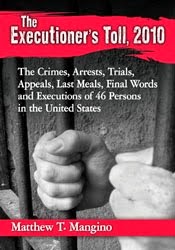Two years ago, a group of Republican lawmakers
toured the death chamber in Oklahoma, which has been responsible for more executions per
capita than any other state in the last half-century. They took in the
jet-black gurney straps, the phone connected to the governor’s office and the
microphone used for last words, write Maurice Chammah and Keri Blakinger in The Marshall Project.
“The hair rises on the back of your neck,” said
state Rep. Kevin McDugle. “A few legislators couldn’t be in the room very
long.”
They continued on to death row to see Richard
Glossip, who has spent more than two decades in solitary confinement, facing
execution for a 1997 murder. Glossip says he had nothing to do with the crime,
and a growing number of conservative lawmakers believe him.
“I just remember putting my hand up on the glass,”
McDugle recalled, “and he put his hand up, and I said, ‘You've got people
fighting for you. Keep your head up, brother.’”
As Oklahoma officials seek
to resume putting prisoners to death later this year, McDugle has
pursued bills in the state legislature to help those on death row prove their
innocence, knowing Glossip could be among the first facing execution.
“My fear is some people will be executed before we
pass a bill,” McDugle said.
Glossip’s case is reaching the highest echelons of
politics in a deep-red state at a time when Republicans across the country are
increasingly split on the future of capital punishment. Support for the death
penalty used to be popular in both parties, but over the last three decades,
Democrats have turned away from the punishment, leaving Republican legislators,
governors, prosecutors and judges to fight for its continued use. At the same
time, a small conservative movement — including groups like Conservatives
Concerned About the Death Penalty — has been openly questioning capital
punishment. It’s now clear their efforts are paying off.
Earlier this year, Virginia became the first Southern
state to repeal the death penalty after three Republicans voted with the state
legislature’s Democratic majority. A Marshall Project review found that in
roughly half the states with an active death penalty system, Republican
lawmakers have recently sponsored or written bills to ban or constrain the
punishment, or to help potentially innocent prisoners avoid it.
Although many of these bills are unlikely to pass,
their sheer volume suggests a significant shift in conservative views. Some of
these Republican legislators see their bills as incremental steps toward ending
the punishment. But others, like McDugle, don’t want to end the death penalty —
they just want to fix it.
“I want to make darn sure that if we as Oklahoma are
putting someone to death, they deserve to be there,” McDugle said. “I know
there is human error all the way through.”
Conservatives have been slowly turning away from the
death penalty for years, as high-profile innocence cases have helped frame
capital punishment as a problem of out-of-control big government. In 2000,
after a series of exonerations of people who had been sentenced to death, the
Republican governor of Illinois, George Ryan, declared a moratorium on
executions. At the time, Texas Gov. George W. Bush was running for president,
and the national
press questioned whether an innocent person had faced execution under
his watch; soon after, his fellow Republicans in the state legislature voted to
make DNA testing more available for prisoners. From 2014 to 2019, Republican
support for the death penalty, as opposed to life sentences, dropped from 68%
to 58%, according to Gallup
Polls. Republican legislators in Nebraska voted to repeal the punishment in
2015, although the state’s residents then voted to bring the punishment back.
Some lawmakers have been motivated by
anti-abortion arguments
about the sanctity of human life and stories of Christian redemption on death
row. Others talk about the cost
to taxpayers. South Dakota state Sen. Arthur Rusch previously served as a
judge in a capital case. “My case cost at least $1 million if not more,” he
said, noting that the court paid for counseling for some jurors who suffered
from post-traumatic stress after the lengthy trial. He was elected to the
senate in 2015, and has filed numerous bills to abolish or restrict the
punishment; none have succeeded, he said, but each time he brings along a few
more peers.
“Changing your mind on an emotional subject like
this can be difficult,” said Hannah Cox, who writes columns for Newsmax, a conservative
web outlet, and serves as national manager of Conservatives Concerned About the
Death Penalty. She’s found that efforts to fix the system can serve as “baby
steps,” as she tries to show her fellow conservatives that the system can’t be
saved. “If you fix one of 13 problems with the death penalty, there are still
another 12.”
Of those problems, conservatives have been less
likely to cite the racial disparities in capital punishment that animate many
of its liberal opponents. Of the more than 2,500 people on death rows around
the country, 41% are Black. In contrast, Black people make up 13% of the total
U.S. population. For his part, McDugle acknowledges the disparity but said it
isn’t what motivated his efforts.
“When I look at a bill, I don’t see color at all. I
look at an individual and say, ‘If an individual commits a crime of this
nature, should they be put on death row or not?’” he said.
Robert Dunham, the executive director of the
nonpartisan Death Penalty Information Center, said it’s wrong to think that
conservative lawmakers only get involved in cases where White people face
execution. “Where the case looks like a 21st-century lynching, it offends
conservatives’ consciences,” Dunham said, adding, “I think that the fact that
extreme injustices also do happen to White capital defendants is eye-opening to
people who have not appreciated the depth of the problems in capital
punishment.”
Many conservatives focus on the moral calculation of
who deserves the ultimate punishment. Ohio recently passed a bill, sponsored by
a Republican legislator, to ban
the execution of anyone with a serious mental illness. Republicans are
pushing similar bills in Florida, Kentucky and Missouri.
In Texas, state Rep. Jeff Leach has filed
a bill that would ban the death penalty for people who were
technically “accomplices” to murders but played a minor role, including getaway
drivers. Much like the Oklahomans, he was motivated by a single case — that of
Jeff Wood, who was sentenced to die after his friend killed a store clerk
while Wood
waited outside in the car, after what they thought would be an easy
robbery.
Though Wood’s case is not in Leach’s district, he
wrote to the North Texas lawmaker and pleaded for help. His letter ended up on
the top of Leach’s pile of prison mail, and he picked it up one day on vacation
when it was too rainy to go to the beach. He’d been hoping to catch up on his
backlog of letters, but Wood’s story sucked him in.
“It’s been on my mind and on my heart ever since,”
Leach said. “Jeff Wood isn’t innocent, but the state shouldn’t even be
considering putting him to death.”
Other lawmakers are more concerned about the risk of
executing an innocent person. Texas Rep. Steve Toth, a Republican lawmaker from
just north of Houston, filed
a bill banning the death penalty in cases where there’s only one
eyewitness and no other evidence. As a Baptist pastor, he was moved by
seeing death
row exonerees speak to the legislature several years ago, as well as
the film “Just Mercy.”
“Even the Bible says you shouldn’t put someone to
death without a corroborated eyewitness,” he said, citing the Book of Deuteronomy in
the Old Testament. “If we’re going to put someone to death we need to be
absolutely certain.”
The crime that landed Glossip on death row took
place in the early morning hours of Jan. 7, 1997, at the Best Budget Inn in
Oklahoma City. Sometime before dawn, owner Barry Van Treese was bludgeoned to
death and left in Room 102. As the motel’s live-in manager, Glossip quickly
became a suspect, and police arrested him two days after the killing.
Later, authorities realized that 19-year-old
handyman Justin Sneed was the one who actually carried out the fatal beating.
They arrested him, too, and under questioning Sneed
confessed, but claimed that Glossip had masterminded the killing.
There was scant evidence of Glossip’s involvement,
but an Oklahoma jury still found him guilty, based largely on Sneed’s testimony.
In exchange for that testimony, Sneed got a life sentence, while Glossip went
to death row.
An appeals court tossed out the verdict, saying
Glossip’s lawyers hadn’t done a good enough job. When the case went back to
trial in June 2004, it ended with the same result.
In 2015, Glossip came within hours
of execution before the governor called it off over a controversy
involving the state’s death drugs. Since then, his case has continued
attracting celebrity attention, and his lawyers say they’ve found more
witnesses who could help prove their client’s innocence. Right now,
they’re fighting
to get access to files the district attorney’s office is refusing to turn
over, but that Glossip’s team says could hold the key to proving his innocence.
A few years ago, conservative business owner Justin
Jackson watched “Killing Richard Glossip,” a four-part series on Investigation
Discovery, the true crime television network, and couldn’t stop thinking about
it. Jackson is friends with Oklahoma Gov. Kevin Stitt, and while the two were
hunting deer, he voiced his concerns. Eventually, he cold-called Glossip’s
lawyer and offered his help, and started talking about the case to friends in
the legislature, including McDugle.
One of
McDugle’s bills would require prosecutors to share materials with defense
lawyers. (Around the country, prosecutors frequently tangle with the defense
over what they must share.) Another bill would
allow the parole board to create a Conviction Integrity Review Unit to study
innocence claims (usually these are housed in county-level prosecutor offices,
although Michigan and Pennsylvania have statewide units.) The third would
create a “Prosecutor Conduct Review Panel,” which would decide what evidence is
potentially favorable and must be given to the defense. (Currently, prosecutors
get to decide.)
McDugle failed to get these bills out of legislative
committees and blamed prosecutors for undermining his efforts. He will continue
to push the proposals next year but also knows it may be too late. He plans to
lobby the state’s parole board directly to study the Glossip case and recommend
that Stitt free him from death row. McDugle has also been swayed to advocate
for a Black
man on death row who maintains his innocence, Julius Jones.
Some opponents of the death penalty hope these bills
will eventually bring legislators like McDugle to the conclusion that capital
punishment is broken beyond repair.
“It’s easier to start naming specific policies you
don’t like before getting to ‘throw the whole thing out,’” said Laura Porter,
executive director of the 8th Amendment Project, which works on anti-death
penalty legislation across the country. “I’ve seen that growth from an
individual issue, or case, to ‘OK, I’m done with it.”
To read more CLICK HERE














